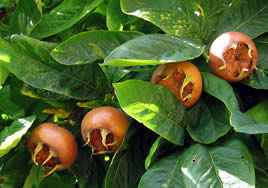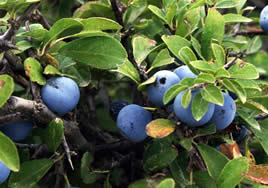The Orchard Of Forgotten Fruits
By “forgotten fruits” we mean those fruit-bearing tree productions such as medlar, serviceberry, Volpina pear, quince, strawberry tree, Cornelian Cherry dogwood, pomegranate, sloe berries, and others, primarily obtained in marginal hilly areas, which were widely known and used by local populations in the past within a self-subsistence agricultural economy. In the past the production was at familiar level, but they are still hardly ever cultivated today.
Today, because of the change in agricultural production methods, mainly directed towards the market, these fruits risk true extinction and, with this, the loss of typical cultural and culinary traditions of the farmers.
The art of cultivating these plants is an ancient practice handed down from generation to generation, in an agro-ecosystem which is particularly suitable for mountain tree crops. Their growth is favoured by a dry climate, strong intensity and quality of solar radiation, by diurnal/nocturnal temperature variation, by copious dew and by an excellent pollination.
Emigration and the excessive fragmentation of land have allowed the development of “family fruit growing”: plants were cultivated almost naturally, preferring those with medium-high stems to allow simultaneous cultivation of cereals, legumes and fodder.
Each farmer jealously guarded their own varieties, even if they were local or from distant places of emigration and the nearby valleys, thus contributing to the selection of an extraordinary heritage of biodiversity. The progressive emigrations process from the countryside has left these cultivations abandoned, putting the genetic wealth of our fields at risk.
The local heritage, which is the result of such hard work by generations of farmers, must be safeguarded and valued to prevent its disappearance. This is the reason why the project to create a park of “minor fruits” was born. It is a journey made of colours, scents and flavours “from the past” to rediscover ancient varieties. Some of these varieties and their characteristics are described below.
It is a typical shrub of the Mediterranean scrub. It is very important because it can regrow very easily even after fires. Due to the fact that it has both delicate-coloured flowers and bright red fruits on green leaves in Autumn, it was considered the national plant during the Risorgimento. In the past, the leaves of the strawberry tree were used for tanning leather, thanks to their richness in tannins. As the scientific name “unedo” suggests, from the Latin “unum edo” meaning “I eat one”, it should not be overeaten as its fruits are indigestible and laxative. Nevertheless, excellent jams, tasty candied fruits, and spirits are made from them. The strawberry tree honey is also excellent and precious for its very pleasant bitter taste.
It is a shrub lover of chalky soils, the Cornelian cherry dogwood is recognizable in Spring for its and early yellow flowering, but also in Summer, for its bright red fruits. Like elderberry, it is a plant with thousands uses known since ancient times. The Latin name “cornus” evokes the hardness of its wood, which was used in the past to make spear and arrow shafts. The bark was also known for its astringent properties. The fruits, which are harvested in August and September when they turn a dark red colour, were used both fresh and in the form of jams and syrups. Particularly noteworthy are the “cornelian cherries” obtained by preserving the fruits in brine when they begin to ripen.
It is a shrub native of Asia Minor. It grows spontaneously in our woods since ancient times. Its fruits, “medlars”, are harvested in Autumn and they have a slightly astringent and diuretic power. Already considered a delicacy by the Greeks and Romans, in our countryside, medlars were harvested unripe and stored in a cool, dry place on a layer of leaves to “ripen”, undergoing a natural fermentation process that begins immediately after ripening and makes them sweeter and softer.
It is a thorny shrub with a lot of branched stems. It grows wild in the woods and it was traditionally used to form boundary hedges. It is easy to see bird nests among its branches, because they feel protected by the thorns. The flowers and bark have astringent and anti-inflammatory properties, while the fruits are used to make jams and liqueurs with a pleasant aroma, even though they are very acidic even when ripe. Only after the first frosts they become soft and pleasant to the taste.
The rosehip is a bushy shrub widespread throughout the territory. Particularly resistant, it can be found up to 1500 meters in altitude. Its berries, rich in vitamin C, are harvested in autumn to make a delicious jam. When dried in the sun and stored in glass jars, they can be used to prepare infusions that are a useful and ancient remedy against winter colds.
Moreover, many legends are related to this shrub. In the villages of the Apuan Alps, it was believed, among other things, that a sprig of rosehip kept at the door would ward off the evil eye.
It is a shrub that prefers damp and nitrogen-rich places, which is why it is easy to find it among the ruins of dilapidated houses. For centuries, humans have been familiar with this plant, from which they have learned to use everything: the leaves, the flowers, and the bark. It is possible to obtain green, lilac, and black dyes, while the wood, which is soft and easily workable, is used to make various tools such as small combs and spoons.
In the past, young boys used its branches to make “stoppieti” which were small and cheap piston guns, or rustic cigarettes.
The medicinal properties have always been well known. Flower infusions were used to treat coughs, flower compress were applied to cure burns and boils and the extract of the roots was used as a purgative. In particular, the flowers, not only have an analgesic, diuretic, and laxative action, but they are also excellent ingredients for syrups, jams, fragrant omelettes and also as a sort of fried pancakes which is called “frittella” in Italian.
It is a shrub which reach a maximum height of 15 meters, very long-lived, and slow-growing. Its wood, which is compact and easily polishable, is useful in carpentry. It grows in forests from the seaside to the sub-mountainous area, preferring chalky soils.
It has been known since ancient times for its fruits, the sorbs, which the Romans fermented together with wheat to obtain an alcoholic beverage similar to beer, called “cerevisiae”. Locally, sorbs are harvested in Autumn and then placed on a layer of straw to ripen. They become edible only when, after a few weeks, they turn brown.










